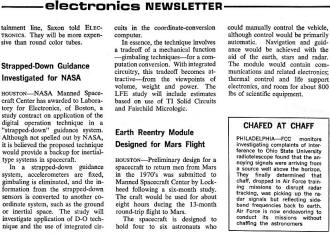|
January 24, 1964 Electronics
 [Table of Contents] [Table of Contents]
Wax nostalgic about and learn from the history of early electronics.
See articles from Electronics,
published 1930 - 1988. All copyrights hereby acknowledged.
|
Remember when the first manned
spacecraft transported astronauts to Mars and then back to Earth in the 1970s -
a 13-month round trip? Yeah, me neither. In the mid-1960s, Electronics magazine reported
on the preparations being made by NASA for Mars travel at the same time they were
busy preparing the Apollo mission to the moon. The world's first manned orbit (Apollo 8) of
the moon didn't happen until in December 1968, a mere seven months before the historic
July 1969 Apollo 11
moon landing*, but NASA was wasting no time planning for the next big thing. Of
course you know to date we never have made it to Mars with a manned spacecraft,
but the headlines are still filled with "any day now" projections by
SpaceX's Elon Musk (whom
I like) and his contemporaries. Sure, I would love to be alive to witness a manned
mission to Mars, but I'd settle for another manned mission to the moon for establishing
a lunar way station for future trips to Mars. Moon base objectionists [sic] say its lack
of atmosphere to burn up meteorites is an insurmountable hazard - just look at all
the craters there! However, the
International Space Station (ISS),
Apollo-Soyuz, Skylab,
Mir, and
Salyut
existed for decades (not at the same time) without a protective atmosphere and without
a major incident. Atmospheric winds have erased nearly all evidence of the meteorites
that have reached the Earth's and Mars' surface; many have impacted over the millennia.
Electronics Newsletter - Earth Reentry Module Designed
for Mars Flight
 Houston - Preliminary design for a spacecraft
to return men from Mars in the 1970's was submitted to
Manned Spacecraft Center
by Lockheed following a six-month study. The craft would be used for about eight
hours during the 13-month round-trip flight to Mars. Houston - Preliminary design for a spacecraft
to return men from Mars in the 1970's was submitted to
Manned Spacecraft Center
by Lockheed following a six-month study. The craft would be used for about eight
hours during the 13-month round-trip flight to Mars.
The spacecraft is designed to hold four to six astronauts who could manually
control the vehicle, although control would be primarily automatic. Navigation and
guidance would be achieved with the aid of the earth, stars and radar. The module
would contain communications and related electronics; thermal control and life support
electronics, and room for about 800 lbs. of scientific equipment.
Chafed at Chaff
Philadelphia - FCC monitors investigating complaints of interference to Ohio
State University radiotelescope found that the annoying signals were arriving from
a source well above the horizon. They finally determined that chaff, dropped in
Air Force training missions to disrupt radar tracking, was picking up the radar
signals but reflecting sideband frequencies back to earth. Air Force is now endeavoring
to conduct its missions without chaffing the astronomers
Posted September 1, 2023
(updated from original
post on 11/19/2018)
|




























